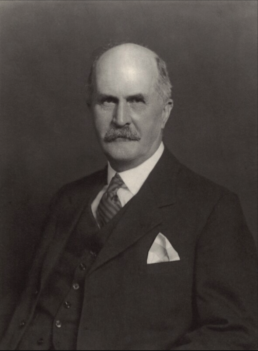These life stories may contain descriptions of childhood trauma and abuse, as well as images, voices and names of people now deceased. If you need help, you can find contact details for some relevant support services on our support page.
Distinguished English physicist and mathematician, William Henry Bragg (1862-1942), was in kinship care as a child.
William Henry Bragg was born in West Cumberland, England, the eldest son of Mary and Robert Wood. Robert Wood joined the merchant navy as an apprentice when he was ten years old; he became a farmer when he retired, six years before he married Mary.
On the day of his mother’s death in 1869, William’s care became the responsibility of his paternal uncle, William Bragg (1828-1898), who was a widower and pharmacist at Market Harborough in Leicestershire. Within William Bragg Senior’s household was William’s grandmother, another paternal uncle, an aunt and two cousins. During school holidays William returned to be with his father and brothers on the farm.
In 1875, young William commenced at boarding school, King William’s College on the Isle of Man. Six years later he was awarded a scholarship to Trinity College at Cambridge University (where he specialised in mathematics).
William successfully applied for an academic position at the University of Adelaide in South Australia in 1885, becoming the joint Elder Chair of Mathematics and Experimental Physics.
Bragg embraced the social and intellectual life in and around the University of Adelaide. He became involved in local institutions such as the Museum and Art Gallery and encouraged the formation of a student union. He married artist Gwendoline Todd, the daughter of the South Australian postmaster general, Sir Charles Todd, who was also an astronomer and electrical engineer. The couple had two sons—William Lawrence and Robert (who died at Gallipoli)—and a daughter, Gwendolen.
Although he had little knowledge of physics initially, Bragg’s interests shifted to this over time and he “developed a flair for expounding the subject both in formal classes and in public lectures often enlivened with experimental demonstrations” (Tomlin).
Working in the new physics of “X-rays, radioactivity, the electronic, positive ions, and ionization of gases” is what excited him, and in 1904 Bragg began “his first experiment on the alpha particles from radium.” He was ready to report on his work eighteen months later and it was not long before he was “a widely recognized worker in the field of radioactivity” (Jenkin). William Bragg was elected as a Fellow of the Royal Society of London in 1907 and appointed as the Cavendish Chair of Physics at the University of Leeds in 1909.
It was while he was at Leeds that Bragg “invented the X-ray spectrometer” and, with his son Lawrence, “invented the new sciences of X-ray analysis of crystal structure” (Dictionary of Australian Biography). For this, father and son were jointly awarded the Nobel Prize in Physics in 1915.
In 1915, William Bragg became the Quain Chair of Physics at University College, London although he didn’t take up his duties until after WWI ended. From 1923, Bragg was Fullerian Professor of Chemistry at the Royal Institution. He was elected President of the Royal Society in 1935.
William Henry Bragg was the recipient of many honours, including having a lecture theatre at King William’s College named after him, as well as The Sir William Henry Bragg Building at the University of Leeds. He was appointed a CBE (Commander of the Order of the British Empire) in 1917, knighted in 1920, and admitted to the Order of Merit in 1931.
References:
“Bragg, Sir William Henry (1862-1942), physicist.” Dictionary of Australian Biography, https://gutenberg.net.au/ebooks15/1500721h/0-dict-biogBr-By.html#bragg1
Del Regato, Juan. “William Henry Bragg.” International Journal of Radiation Oncology, Biology, Physics, vol. 7 (1981): 83-97.
Jenkin, John. “William Henry Bragg in Adelaide.” History of Science Society, vol. 95 (2004): 58-90.
Tomlin, S. “Bragg, Sir William Henry (1862-1942).” Australian Dictionary of Biography, https://adb.anu.edu.au/biography/bragg-sir-william-henry-5336
Image available here.
